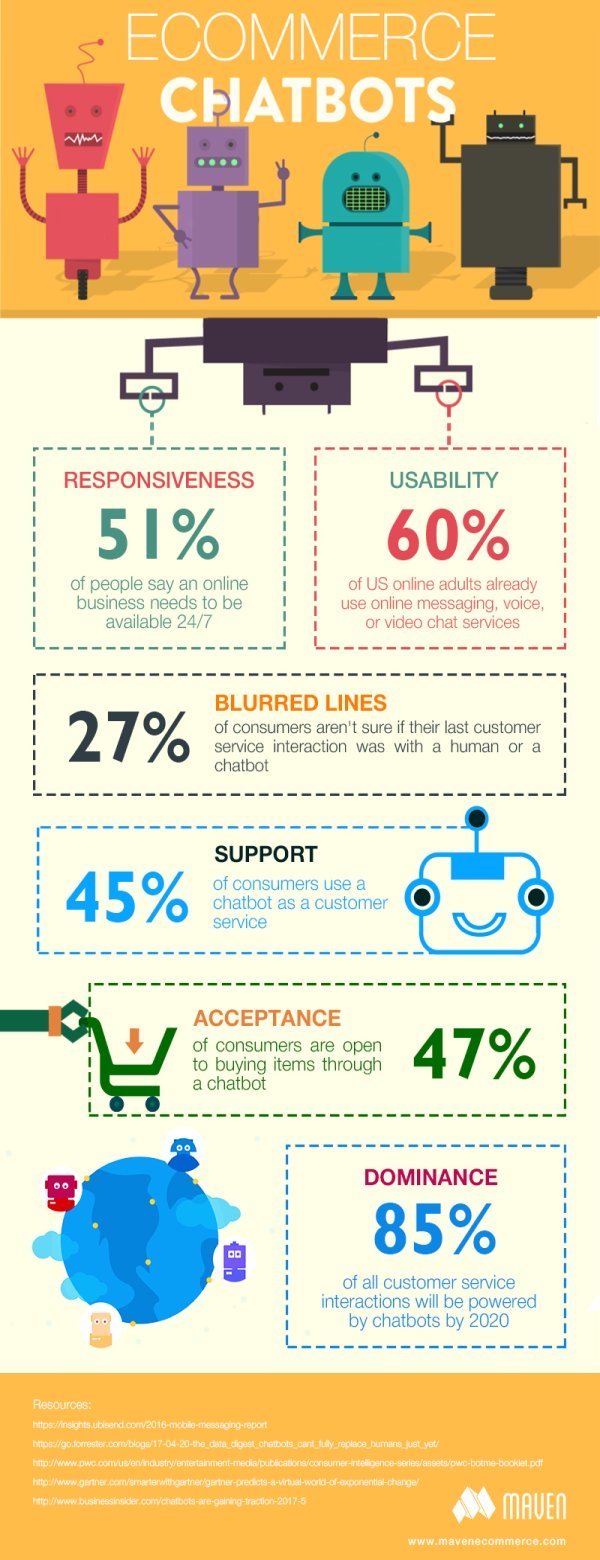Online businesses are struggling to attract more and better leads and customers. It seems that every single well-known marketing technique has already been exploited so far. However, the top players in the eCommerce market are growing and flourishing. For instance, such a retail titan like Amazon accounts for 43% of U.S. online retail sales in 2017. Moreover, it is going to boost its market share above 50% by 2021.
Well, putting aside large-scale e-retailers with their immense resources, it is still unclear what mid-sized online businesses should do to stay competitive in the upcoming 2018 pursuit. Quite obviously, they should utilize some kind of an unconventional strategy that implies doubling down on brand new or unexhausted solutions. In view of this, making use of chatbots in eCommerce looks like a very promising option.
From a chatbots’ history: flashback
Virtual assistants that help establish and conduct communication using voice or text methods are not at all a brand new phenomenon. Over many years there were tries to create computer-aided intellectual models to be able to converse on a par with us, humans. Unfortunately, they were not sentient enough and could go any further than following elementary messaging scripts. Later on in the 2000s, chatbots already managed to do more than a thing or two, however, they were way far from what is called full interaction either.

A watershed moment for chatbots in eCommerce
What has changed after all? The digital world seems to have been knee-deep in this chatbot hoopla in recent years. The answer is on the surface. All this info online accounts for outpaced growth in the development of AI or Artificial Intelligence, pure and simple. AI, empowered with machine learning (ML) together with deep learning approaches, big data processing, neuro-linguistic programming (NLP) and other crazy things, enables this type of computer software not to just mimic human communication process. It makes possible for the programs to learn from humans, namely to analyze the very semantic core of discourse and to infer interaction patterns. Oracle looks very optimistic on this matter, predicting that 80% of business entities will employ chatbots for interactions with their customers by 2020.
What eCommerce customers should expect
Nowadays it is not an eye-opener anymore that virtual assistants can maintain a meaningful and convincing machine-to-human dialog. Let’s have a closer look what they are utilized today for.
In our ever-changing world people evolve greatly altering their consumer behavior. They need massive social broadcasting no more, preferring instead more personal (and personalized) interaction when it comes to business activities of any kind. A study conducted by Salesforce partners has shown that 85% will prefer using chatbots across digital channels for sales and service, providing it can save time and make a problem-solving process easier.
So people strive for less emailing and phone calls in their private lives, opting for messaging and social media. The same thing they demand from the brands they communicate with. That’s where chatbots, equipped with smart AI, come into play. According to Ubisend 2017 Chatbot Survey, 73% of UK consumers find adopting the chatbot technology to be innovative and helpful. When taken globally, the Business Insider experts state that 38% of shoppers consider their overall perception toward chatbots as being positive.
Chatbots can satisfy all parties and all channels
With this in mind, it is no wonder that businesses have been going big time to exploit chatbot-enabled solutions to attract more customers to their brands. Therefore, eCommerce turns to be an ideal place for this technology. When the early adopters like Amazon, have already struck gold, the late movers – mostly mid-sized companies being brick-and-mortar once as well as startups – are making first steps to integrate virtual assistants with their eCommerce platforms.
Well, it is quite obvious that chatbots are geared for online business. It may sound a bit weird, but chatbots become an inevitable part not only for digital merchants but also for a conventional business sector. It is considered already that chatbots a must-have feature for a trendy bricks-and-clicks business model. Even if customers prefer visiting a nearby store, they can get all the info on products and services with a help of online messaging application.
Chatbots stand by your business side
No matter what type of online business you run as well as products or services you offer to your customers. Just zero in on the following pivotal outcomes you will benefit by applying chatbots to your eCommerce platform.Chatbots are beneficial for e-commerce businesses in many ways, and can be used to do the following:
- enhance the shopping experience by reducing wait time. Since chatbots can provide customers with instant answers while examining products;
- retain and re-engage customers by sending messages;
- provide 24/7 support;
- avert shopping carts from abandonment by reminding visitors about the unfinished orders and providing answers to common questions;
- reduce expenses by reducing the number of chat operators or even eliminating the need for them.
Rules to follow for making success with chatbots
Realize your place. Never pretend to be human. Do the things that bots are really good at like responding fast and collecting information. Don’t attempt anything you’re not good at.
Respect privacy. Chat only when you are invited. Authenticate whom you represent and never share a person’s personal information.
Serve fair. Deep integration with all eCommerce systems will allow you to service all requests and to be proactive handling status changes on any transaction.
Understand context. Remember information from earlier in the conversation and use this in addition to things you know like time and location to provide a contextual response.
Be efficient. Respond to the human as fast as you can, provide buttons or images that make it easy for them, and if you have trouble understanding, ask clarifying questions.
Master the conversation. A conversation with a bot is better than a webform because the human can use plain language to tell you things – so make sure that you can interpret their words and respond without delay.
Handle objections. If you really can’t provide an answer to a request, get as much information as possible without getting into a loop, then pass it to another human via chat, phone or email.
Should you get interested in chatbot integration solutions, feel free to contact our experts.
